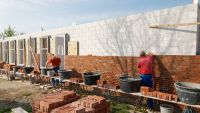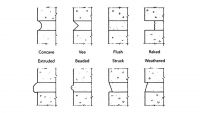A Misunderstanding or a Mortar Failure?
By Brian Carney
In the construction industry, standard specifications and test methods are established to ensure that building materials are properly produced for compliance. However, too often the objective of tests and their results are misinterpreted. Field testing of job site mortar is included in a project specification for pre-construction and construction evaluation only, not to be compared to the performance parameters for a material specification. Unfortunately, in some cases, the end result is an "apples to oranges" comparison in which the final product presumably fails to meet specification.
When the subject is masonry mortars and field testing, pay close attention to the following statement printed by the American Society for Testing and Materials (ASTM): "The test results obtained under the test method (C 780) are not required to meet the minimum compressive strength values in accordance with the property specification in Specification C 270." This statement is found in the Scope of ASTM C 780 Standard Test Method for Pre-construction and Construction Evaluation of Mortars for Plain and Reinforced Unit Masonry (section 1.3). Appropriately, the committee members are assigned to ASTM C 780 have included this comment in the standard's scope to help avoid any possible confusion. There is a simple reason for this assertion.
It should be no surprise that the water content of a given mortar will have a dramatic affect on the specimens compressive strength. Laboratory mortar complying with C 270 is produced with an insufficient amount of water conducive to good field working conditions or fluidity. Mortar made at the job site, which is often tested in accordance to C 780, will have additional mixing water to accommodate the absorption of the masonry unit.
After 28 days of curing, the 2"x4" cylinders cast from construction mortar at a flow (fluidity) greater than 135% will attain only 71% of the compressive strength achieved by the same mixture tested in the lab at 105% flow. In theory, then, if 1800 psi is desired for C 270 Type S mortar, job site mortar should only be expected to attain a strength of 1278 psi.
Construction mortar sampled in the field using ASTM C 780 should not be expected to obtain as high a strength as mortar prepared in the lab using ASTM C 270. This fact is commonly misunderstood which leads to problems. Occasionally, design professionals have shut down projects due to misinterpretation of field test results. Tests conducted under C 780 were intended to evaluate field mixed mortars for consistency and composition, not conformance to property requirements in C 270. Factory pre-blended mortar offers the customer accurately weighed mix designs, and the opportunity to test according to C 270. The proper field testing of pre-blended mortar would involve sampling the dry premixed mortar and running the compressive test under the requirements of C 270.
About the Author
Brian Carney is the Vice President and General Manager of SPEC MIX, Inc. He has served as the Marketing Committee Chairman for the Mason Contractors Association of America.


















